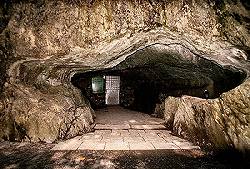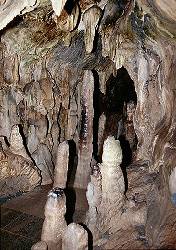Bilsteinhöhle
Bilstein Cave
Useful Information

| Location: |
Warstein.
A44 exit Erwitte/Anröchte, B55 14 km bis Warstein, in Warstein rechts ab nach Hirschberg, Beschilderung Tropfsteinhöhlen/Tierpark, nach 2 km links der Straße, Parken beim Waldhotel Tropfsteinhöhle, 10 min./350 m Fußweg. (51.4249326, 8.3223884) |
| Open: |
APR to OCT daily 9-17. NOV to MAR daily 10-16. Last tour 30 min before closing. [2021] |
| Fee: |
Adults EUR 6, Children (3-16) EUR 4, Children (0-2) free, Dogs EUR 2.50. Groups (15+): with reservation only. [2021] |
| Classification: |
 Karst Cave
cave system, middle Devon (reef limestone) Karst Cave
cave system, middle Devon (reef limestone)
|
| Light: |
 LED LED
|
| Dimension: | BH: L=30 m, W=20 m, H=25 m. |
| Guided tours: | L=400 m. D=40 min, V=37,000/a [2005]. |
| Photography: | allowed |
| Accessibility: | no |
| Bibliography: |
Franz Adolph Roters (1973):
Die Bilsteinhöhlen in Warsteinn,
Hrsg. SGV-Abteilung Warstein.
( ) )
|
| Address: |
Bilsteinhöhle, Im Bodmen, 59581 Warstein, Tel: +49-2902-811 and +49-2902-2731 (cave guide).
E-mail: Stadtverwaltung Warstein, Dieplohstr. 1, 59581 Warstein, Tel: +49-2902-81-0. E-mail: |
| As far as we know this information was accurate when it was published (see years in brackets), but may have changed since then. Please check rates and details directly with the companies in question if you need more recent info. |
|
History
| 1887 | discovered by a lumberman who made trails for the Verschönerungsverein Warstein ("beautification association of Warstein"). |
| 1888 | excavation by Carthaus. |
| 1888 | opened to the public. |
| 1928 | excavation by Andree. |
Description


The Bilsteinhöhle (Bilstein Cave) has a subterranean river. This is called Bilstein-Bach (Bilstein brook) and flows subaerial until it reaches the small limestone area of the Bilstein where it vanishes in sinks (ponors). It reappears in two springs about 300 m to the north, inbetween it is responsible for the formation of caves.
Close to the sinks, three small caves, which were inhabited by Stone Age man, were known to the locals for a long time. The caves contained remains of the Paleolithic (Old Stone Age). During excavations in one of those caves, a continuation was discovered, which is now known as Bilsteinhöhle.
The Bilsteinhöhle has several levels. Only two upper levels are open to he public, which are dry. The lower level is waterfilled, at least part of the year, as the Bilstein brook dries up during summer and autumn.
The cave has some nice speleothems, stalactites and stalagmites which sometimes grow right in the middle of the tour path. The visitor walks through a forrest of stalagmites. The main chamber has an irregular shape and is crossed several times during the tours, although it looks different from different angle, so many visitors actually do not notice that they have been here before. Stairs in this hall allow the descend to the lower level and back up, which gives the hall a touch of the famous Escher painting. But the most impressive part of the cave is the passage at the entrance, with its strange shape. This passage was formed by the erosion of the flowing water of the Bilstein brook, when it flew higher and probably had more water. Characteristic is the wide convexity to both sides.
Beneath the Bilsteinhöhle there are several other caves in this small karst area. The Hohle Stein (Hollow Rock) is a paleolithic cave at the Lürmecke. At the 422 m asl high Hohen Liet is the system called Liethöhlen.
The whole area around the Bilsteinhöhle has a complex geologic structure. In general the limestone is the core of a saddle, which is very common for the small limestone patches around the Sauerland. But this saddle has a complex structure with several thrusts. The loosing stream, sinks and springs around the cave are typical for the border to insoluble rocks.

|
| Bilsteinhöhlen Gallery |
 Search DuckDuckGo for "Bilsteinhöhle"
Search DuckDuckGo for "Bilsteinhöhle" Google Earth Placemark
Google Earth Placemark OpenStreetMap
OpenStreetMap Wildpark Warstein, official website. (
Wildpark Warstein, official website. ( Index
Index Topics
Topics Hierarchical
Hierarchical Countries
Countries Maps
Maps